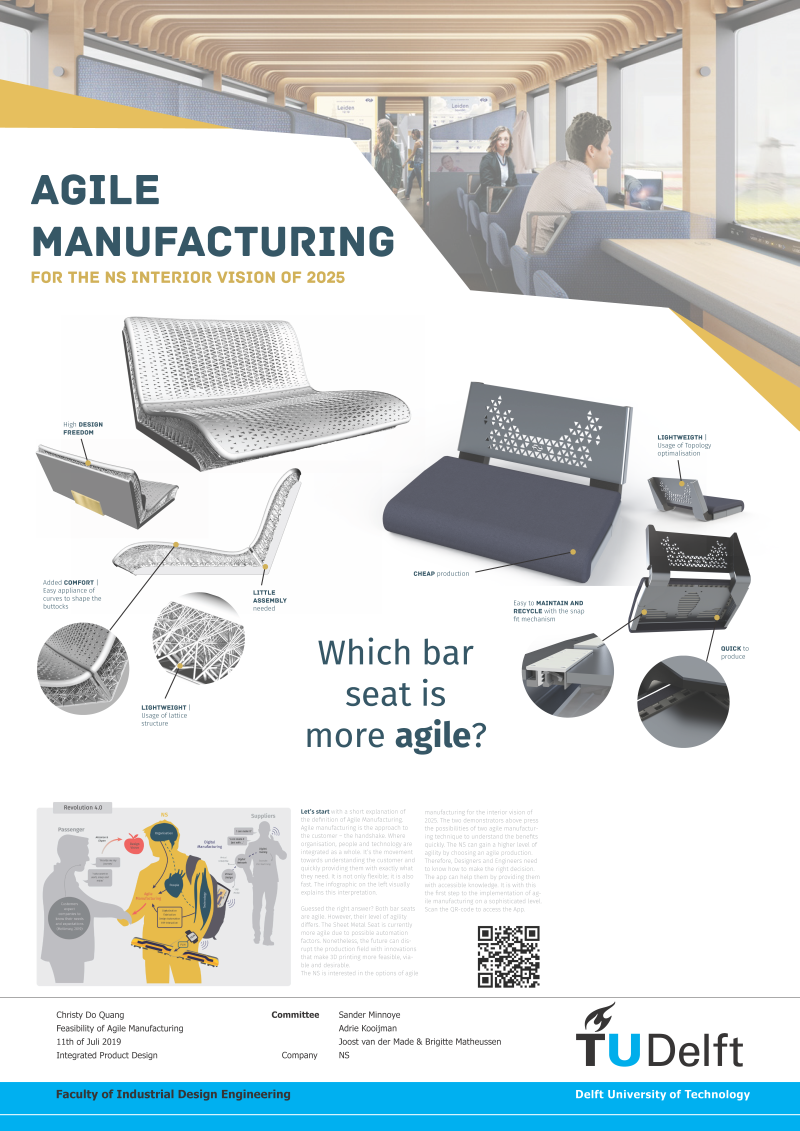Graduation of Christy Do Quang
Commissioned by NS, Christy Do Quang recently graduated with her research on Agile Manufacturing. To realize the new service driven vision of NS, Christy looked in to the possibilities, advantages and the feasibility for the adaptation of Agile Manufacturing in the creation of the new train interior.
Customer service is key in the new vision of the NS. According to Francine Houben – an award-winning architect from Mecanoo – the current interior of the train outdated. The focus for the new interior should be on the modern passenger. Therefore, Mecanoo and Gispen performed an extensive analysis for the NS and designed an innovative and sustainable train that fits within the needs of the train traveler. They researched the activities and profiles of train passengers and developed a pallet of interior elements that optimally supports the various activities. The new train is more than a place that you gets from A to B. It will be a place with space for your activities and own free interpretation
The new concept has furnishing components that are based on a modular system, as it allows faster adaptations and a bigger variation per train set. The production of the interior components is increasingly easier due to the growth of technological developments. For example, design partner Gispen has already shown what the added value of 3D printing technology can be in the production of its bank 'Sett'.
Agile manufacturing (AM) enables flexibility to the production since the NS can respond faster to the customer and market changes and at the same time control costs and quality. The NS is interested in the role that AM can play in the realisation of its vision on the train interior for 2025.
What exactly is AM and what can we do with it? AM is a method of integration where organization, people and technology act as a whole. This integration allows speed, cost efficiency, responsiveness, flexibility and productivity in the fabrication and delivery of products. Therefore, it is easier to realise the satisfaction of consumer experiences. Examples of possible advantages are: keeping a greater diversity of furniture components manageable and affordable, using sustainable materials and increasing flexibility.
New developments also bring limitations and uncertainties. Is the application of AM within the NS feasible? Doesn’t the application cost too much? Moreover, are the changes within the organization desirable?
Extensive research was performed to answer these questions by doing desktop research, field research, interviews and other research methods. The Design phase focused on the technological aspect of Agile Manufacturing. The study showed that the NS already participated in the agile movement. However, their agile manufacturing skills, related to different techniques and production processes, are still behind in comparison to other companies like their competitor Arriva (Deutschen Bahn). Therefore, it was desirable for the NS to apply digitalization, fabrication and design automation to their workflow to gain more agility.
By clustering insights, the conclusion was drawn that quality control, flexibility and design freedom were highly demanded features. These features were divided among the Design Directions regarding digitalization, fabrication and design automation — multiple ideas were created which resulted in an App and two demonstrations.
A higher level of agility can be reached by enlarging the design freedom of designers by improving their knowledge with automated design tools. The App was designed and programmed to give designers and engineers a quick tool to process different manufacturing techniques, including relevant types of 3D printing. (Scan the QR-code). Quick and easy access to high-level knowledge improves design automation which leads to speed, responsiveness and more productivity.
The two demonstrations were made to exploit the possibilities within a type of production. Laser cutting and CFF ( Continuous Fiber Fabrication) were chosen to test the cost-efficiency and the feasibility of the application.
Deployment resulted that both current designs were not feasible. The Laser cut demonstrator needed more design attention with regards to aesthetics and comfort, while the CFF demonstrator was not desirable due to its price. Future developments that make the CFF print cheaper, ecological and quicker to produce would regain their interest.
